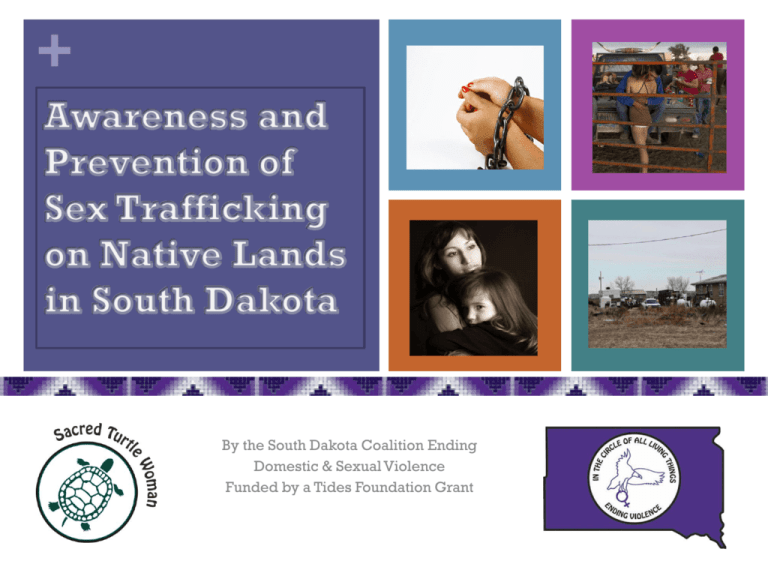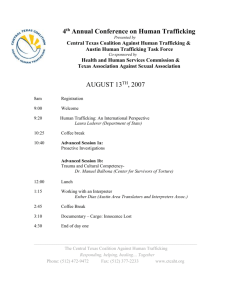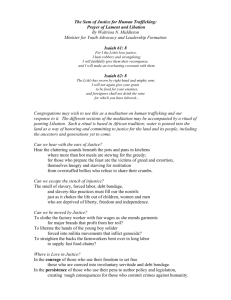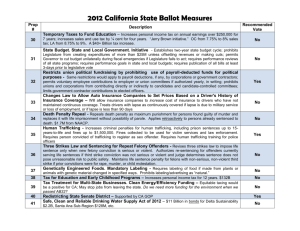
+
By the South Dakota Coalition Ending
Domestic & Sexual Violence
Funded by a Tides Foundation Grant
+
Many Indigenous languages
have no words for rape,
prostitution, and many oral
histories and historical
documents indicate that
violence against women was a
capital offense.
Women
were/are sacred in
Indigenous cultures
Children
were considered gifts
from the Creator
+
Colonization
of the “New World”: "A hundred
castellanoes (a Spanish coin) are as easily obtained for
a woman as for a farm, and it is very general and there
are plenty of dealers who go about looking for girls;
those from nine to ten (years old) are now in demand."
--Christopher Columbus
As
Columbus began exporting Tainos for slavery, sex
slavery became an important aspect of his slave trade
The Taino
resisted their enslavement so Columbus cut
off their hands and set dogs on them as punishment. By
1555 every single Taino was dead.
+
Trafficking
is not new to Indian
country; Part of the “Forts” and
establishments of reservations.
Every
fort, and every trading post was
surrounded by brothels. Did white
women come over with their men? No,
not for 100 years. Who filled these rape
chambers? Indigenous women, that’s
who!
--Jackie Lynne, First Nation
intergenerational survivor
+
Import
of European culture—waterways, railroads,
ships, lumber, mines, forts, trading posts
European
men sold & traded Native women and
girls for alcohol
Hudson
Bay Fur Traders made it illegal for
European women to immigrate into Canada
European
men took Native women as wives
+
Survival at Crow Creek 1863-1866
U.S. - Dakota War of 1862
In retaliation of their participation the U.S. – Dakota War, 38
Dakota men were hung in Mankato, MN , and the remaining
adult warriors were sent to Davenport, Iowa for three years.
May 1863 Journey from Fort Snelling – US soldiers herded
1,318 Dakota women, children and elderly on steamboats, one
went as far as Hannibal, Missouri and then into freight cars (60
to a car) for the trip across Missouri to St. Joseph, the second
boat traveled to St. Louis, where they boarded the Florence.
That vessel made its way up the Missouri to St. Joseph. Packed
even more tightly on the Florence for the remaining 100 miles
chained two by two.
+
Crow Creek Survival
Continued…….
The Dakota remained imprisoned for another 12 days. Only
food available was “hard bread and mess pork that was not
cooked”. Hundreds of deaths started soon after the journey
began and the Dakota, prevented from giving their dead
customary burials.
May 9, 1865 Williamson testified to the congressional
commission “for six weeks after they arrived at Crow Creek
they died at an average rate of three or four a day. In that time a
150 died, and during the first six months two hundred of them
died, and I think that as least one hundred of them died on
account of the bad treatment they received after they left Fort
Snelling.”
+
Crow Creek Survival Continued
After their arrival to Crow Creek food and supplies were
inadequate, insufficient, and rotting. Hunger and illness
continued to plaque the Dakota.
1864 – 1866 Col. Robert W. Furnas reported sexual assault at
Crow Creek
Col. Robert W. Furnas attitude gave them permission to rape
Dakota women
For Dakota women , survival at Crow Creek thus meant
enduring rape as well as the violence of brutal physical
conditions
+
Crow Creek Survival Cont.
The climate of sexual violence, coexisting with the lack of food
and other necessities, forced women into the impossible
choices for themselves and their daughters.
Dakota women at times prostituted themselves to earn money
to feed their families.
The absence of able bodied men to help provide for families
heightened the need for women to use all means possible to
acquire food and supplies, and the sexually degrading views of
white men combined with their economic and military power
over the Dakota, increased the sexual exploitation of women at
Crow Creek.
+
Crow Creek Survival Cont.
This exploitation was well known to officials at the time. One of
the questions asked by the congressional commission studying
conditions at Crow Creek was: “Do you know of Dakota women
being pressed so hard with hunger that they prostituted
themselves in order to get something to eat?” When
commissioners posed this question to David Fairbault, He
replied:
I know of many such cases - women who were virtuous before
they came here, others, who had daughters, would sell them for
something to eat….numbers of women have left the agency
and gone to Forts Sully, Randall, Wadsworth, the Yankton
agencies, and other points, to obtain their living.
+
Human Trafficking
is a Modern Day form of Slavery
Human
trafficking is both “sex trafficking” &
“labor trafficking,” affecting men and women,
children & adults
Trafficking
occurs in the commercial sex industry
and in forced labor or services
+
Trafficking is against Federal and State law to
recruit, harbor, transport, provide or obtain a person
through the use of force, fraud or coercion to engage
in prostitution, pornography and exotic dancing, or
other forced labor.
+
The
U.S. Attorney’s Office reported that 40% of the
victims, from 3 federal cases, were Native women.
Those cases included Mohamed Alaboudi, Carl Cambell and Branden
Thompson.
Pimps
sometimes seek out Native Americans
because they can masquerade them as having
exotic ethnicity—such as Polynesian, Asian, or
Latino. This makes Native women more lucrative for
a pimp.
+
South Dakota Tourist Mecca and
Sex Trafficking – It Can Happen
Anywhere, at Anytime!!
South
Dakota has several hunting seasons all
across the state.
The
Sturgis Bike Rally draws thousands of
motorcycles each year.
This
year (2015) marks the 75th anniversary of the
Sturgis Bike Rally , and will be one of the largest
biker gathering ever from August 3 – 9, 2015
+
“Wherever you have a large gathering
of men, you have a strong opportunity
for prostitution and sex trafficking.”
~ U. S. Attorney Brendan Johnson (2014)
+
Anywhere, Anytime!
Deadwood
is also another tourist location,
with several all-night casinos
Native
Casino are also targets and outlet of
traffickers.
Truck
State
Stops, Malls, Sporting Events, etc.
Fair, County Fair, and Pow-wows.
+
South Dakota U.S. Attorney, Brendan Johnson’s 2013 Annual
Report states that South Dakota is committed to prosecuting
perpetrators of these violent crimes with the maximum
sentencing possible.
In March of 2014, South Dakota sentenced 45-year-old
Mohammed Alaboudi, from Sioux Falls, SD, to four life terms
behind bars for sex trafficking young girls in what was called
the House of Horrors.
In 2013 defendants received sentences of 33-½ years, 30 years,
and 10 years. During that same timeframe, 11 more people were
indicted on sex trafficking and related charges, and others were
convicted and scheduled for sentencing.
+
There is no one face of traffickers. They include a wide
range of criminals.
Sex traffickers may be called pimps or “boyfriends.”
Sometimes they are relatives of the victim, or pose as their
employer.
There are also Madams, or women who prostitute young
girls
Traffickers may be small or large business owners, be
part of a loose knit decentralized criminal network or
international organized criminal syndicate.
The majority of customers are male and are called
“johns”.
Relatives or “Friends”
+
Traffickers seek their victims from group homes,
women shelters and poverty stricken areas
Pimps prey on victims as young as 12 to 14 years old.4
One study estimates as many as 325,000 children in the
U.S., Canada, and Mexico are at risk each year for
becoming victims of sexual exploitation.5
A history of physical and sexual abuse is often common
among victims.6
One study estimates 30% of shelter youth and 70% of
street youth are victims of commercial sexual
exploitation. They may engage or be coerced into
prostitution for “survival sex” to meet daily needs for
food, shelter, or drugs.7
+
How Are People Recruited Into Trafficking?
Traffickers target people, usually young people and women, who
are vulnerable, isolated, trusting and desperate.
Traffickers may use friends and relatives to help recruit victims.
They may pose as someone the victim can trust.
Alcohol and other drugs often play a large part in manipulating
victims.
Sometimes victims are trained to call sex traffickers
“daddies”, “ and themselves “wifies” – a perverted reflection of
the family unit that these children are seeking. These children
long for a family…even if it means being subjected to extreme
violence and abuse.
The term “Boyfriends” and “Girlfriends” are also used.
+
Young people might be invited to parties, to meet at the mall,
restaurant or just to become friends, at first.
The Pimp may start up what the victim views as a romantic
relationship by him buying them clothes, gives them a place
to stay and food.
“friendship” sometimes becomes a trap when girls are
forced into providing sex-for-sale, often with a dozen or more
men a night.
+
Force: Rape, beatings, confinement
Fraud: False offers of caring, marriage, employment,
a better life
Coercion: Threats to harm the victim or their family &
friends, debt-bondage, psychological abuse
Addiction: Forced Alcohol and drug usage
Lisa’s Story: Lisa, a native girl from Minnesota
was only 12 yrs old when her own mother started
selling her to get Meth.
Lisa was addicted to alcohol and drugs at age 16
and she too started recruiting other young girls
to get money for her addiction – Vicious Cycle!!
+
Poverty
Alcohol/Drug Abuse
Domestic & Sexual
Violence
Incest & Rape
Gang Activities
Foster Care
Fueled by Alcohol, Drug Addictions, Gambling = Selling Children!!
+
Meth
abuse rates have reached 30 percent
on some rural Indian reservations, and in
some Indian communities as many as 65
percent of all documented cases involving
child neglect and placement of children in
foster care can be traced back to parental
involvement with methamphetamine.
Reports
quote that 85% of adults are
addicted to Alcohol on Indian Reservations
– Some children start as early as 6 yrs old.
+
Girls (and sometimes boys) are
often initiated into gangs by being
raped by members and then traffic
or “Pimp them Out”.
+ Fact - Foster care children are targeted
by traffickers because of their need for
love, affirmation, and protection.
+
Sex traffickers reach girls (and boys) via social media
Young girls and boys are often lured through on-line social
media sites such as; FaceBook, MeetMe, Twitter, BeBo,
SnapChat, Tumblr, Vine, and other various Chat Rooms
Traffickers or “Pimps” surf the WWW looking for pretty faces
as young as 12 to “CHAT” with and begin the Grooming.
+
+
Dakota Connection – Sisseton-Wahpeton Oyate Tribe
Grand River Casino & Motel– Standing Rock Sioux Tribe
Prairie Wind Casino & Motel – Oglala Sioux Tribe
Lode Star Casino & Motel – Crow Creek Sioux Tribe
Golden Buffalo Casino & Motel – Lower Brule Sioux Tribe
Rosebud Casino & Motel – Rosebud Sioux Tribe
Royal River Casino & Motel – Flandreau Sioux Tribe
Fort Randall Casino & Motel – Yankton Sioux Tribe
Cheyenne River Hotel – Cheyenne River Sioux Tribe
+
Dakota Casino Intelligent Unit
National Indian Gaming Association - In an effort to protect
Indian gaming, a variety of intelligence agencies, commonly
referred to as “units,” were created to share information
among tribes.
Each unit is technically working independent of each other
and focused on scams and cheats in their geographical area.
The intelligence units serve the tribes by providing
heightened awareness and sharing intelligence among
tribes on internal and external theft, including keeping the
organized criminal element out of tribal casinos.
+
How are Casino or Hotel Security
Handling Sex Trafficking?
Many times the John is non-native so cannot be
prosecuted by the tribe.
“They can be kicked off the reservation and taken to
the border, but they always come back after a month or
so” said one casino security guard.
Update: with the amendment to the 2013 Violence
Against Women Reauthorization Act, tribes will be able
to prosecute non-tribal members for Domestic
Violence.
Training, update to Tribal laws, and to Casino/Hotels
policies and procedures is needed.
+
Interstates
90 & 29, and other highways, which run
through South Dakota, are part of the “Midwest
Pipeline,” the superhighways used to deliver
trafficking victims to cities across the country.
Human
trafficking generates billions of dollars
each year in illicit profits, in the United States and
globally, through the entrapment and exploitation
of millions of people, mostly women and children.
The growing illegal trade in human beings for sex
or forced labor isn’t limited to either rural outposts
or the world’s largest cities.
+
“Midwest Pipeline” – I-90 and I-29
+
The Other Side of the
Bakken Oil Boom
+
Rock’n The Bakken – Slogan of
Williston, ND
In
2008 the Population of Williston, ND was 15,000
In
2014 the Population is at 45,000.
There
are 100 Men to one Woman Ratio in the
Bakken today
There
are only 50 Police officers in the area and
they are overwhelmed.
Sex Trafficking
is an Infestation!!!
+
+
+
Grace Her Many Horses (2014)
“When I first got there some of the things they talked about,
in any of these areas, was they told the men ‘Don’t go out and
party. Don’t get drunk and pass out. Because you’re going to
get raped,” she said without hesitation.
“Sexual assaults on the male population has increased by
75% in that area,” she continued. That kind of statistic makes
maximum security prisons look like the minor league.
“One of the things we ran into while working up there was a
15 year old boy had gone missing. He was found in one of the
Man Camps with one of the oil workers. They were passing
him around from trailer to trailer.”
+
MAN CAMPS
No one will say that all of the inhabitants are criminal but there is
definitely an element there that has rocked the local law enforcement
officials to the very core of their morals and value systems.
“We found a crying, naked, four year old girl running down
one of the roads right outside of the Man Camp. She had
been sexually assaulted.”
The sex offenders are very prevalent. “We found thirteen sex
offenders in one Man Camp and that Man Camp is found
directly behind the tribal casino. Our supervisors would tell
us “Watch your kids. Don’t let them run through there.”
She pulled over two vans heading out towards a Man Camp,
filled with female passengers of varying ages. One of the
brazen occupants declared outright to her, “Well, you know
why we are going up there.”
+
There are identifiable variables
that remain constant:
These oil workers usually come from desperate conditions.
These workers usually have a family they have left elsewhere so
they are not looking to start new relations.
These workers are paid an excessive amount of money.
These workers are well aware their employment is only
temporary.
These workers know they are living in a remote environment
where law enforcement is already stretched beyond its limits
and the temptation for criminal behavior is very strong.
Unfortunately, most of America still cannot comprehend this
information.
+
Cannot by their own food or clothes
Cannot come and go freely
Not allowed to have friends, go to school or contact friends
or relatives
Embarrassed, ashamed and over-whelmed
Malnourished
Scarring, cigarette burns, tattooing/ branding
Alcohol/other drug abuse or addiction
Traumatic brain injury, post-traumatic stress, anxiety
disorder depression
+
Does Your Tribal Law Enforcement codes include Human
Trafficking?
Since Trafficking is prosecutable under Federal, most all
trafficking cases to date have gone federal
How many Trafficking Cases are from Tribal Courts
What has been the Outcome?
Has the victim received help?
Have you seen or know of sex trafficking happening?
+
Law Enforcement Training
Shelter and safe places
Advocacy Training
Counseling and Resources
Prevention Awareness
+
Sex Trafficking can happen anytime, anywhere!
Be Aware of your surroundings. Kidnapping is a
common way that traffickers get their victims, so pay
attention!!
Watch for the signs in your family and community and
start open discussion about this crime.
Seek help and/or report this crime to local law
enforcement
If you see it, Report it.
PIMPING OUT = CRIME!
+
Pathfinder Center
Pathfinder Center is a program under Wiconi Wawokiya, Inc.
and is community based, 501 c3 nonprofit, 14 room program
located in Central SD
Wiconi Wawokiya, Inc. (Helping Families) is seeking
support for our new Pathfinder Center. The mission and
purpose is to provide a place of refuge for victims of human
trafficking from all over South Dakota, and to promote the
growth and development of those we serve by empowering
them to experience healing and wholeness while ensuring that
each woman gains a sense of self-worth and the capacity to
achieve their full potential and find their true purpose.
+
Key objectives of the Wiconi
Wawokiya’s Pathfinder
Center include:
Women have stable, safe housing and are protected from traffickers.
Women become part of a healthy, safe community of support that provides
assistance while they address pressing legal, medical, and emotional needs.
Women learn life skills such as communication, conflict resolution,
understanding boundaries, understanding trafficking & trauma, and making
safe choices to help them live independent lives.
Women receive addiction counseling, job skills/GED classes, emergency
counseling and transportation.
Services will also include a crisis hotline, clothing, food and hygiene items.
+
For more information
911 - Will dispatch an officer- may not be trained to
respond to trafficking cases, but best for immediate
emergencies.
Polaris Project - Nat’l Human Trafficking Resource
Center - 1-888-3737-888 www.polarisproject.org
Call to report a potential case of trafficking, request
training or info. * 24-hour capacity
U.S. Dept. of Justice Trafficking Persons & Worker
Exploitation Task Force Line - 1-888-428-7581
Direct to federal law enforcement Weekdays, 9am to 5pm EST
SD Coalition Ending Domestic & Sexual Violence
1- 800-572-9196 Referral only
www.sdcedsv.org
PowerPoint and Presentation provided by
Carla R. Marshall, SDCEDSV Tides Grant Coordinator
605-545-1430 or 605-342-0220
+
Make the Call
+









